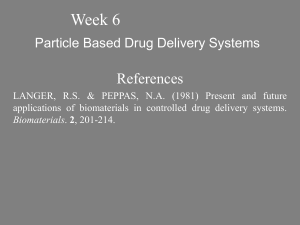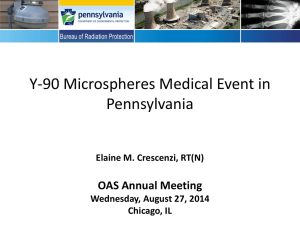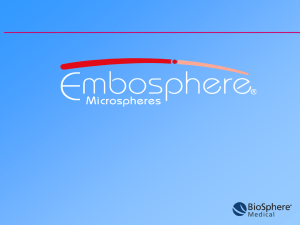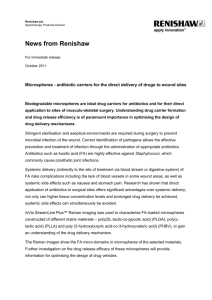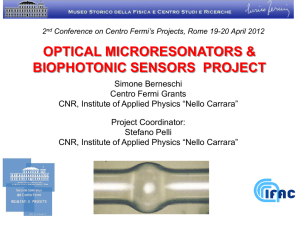degin and development of transdermal drug delivery system
advertisement
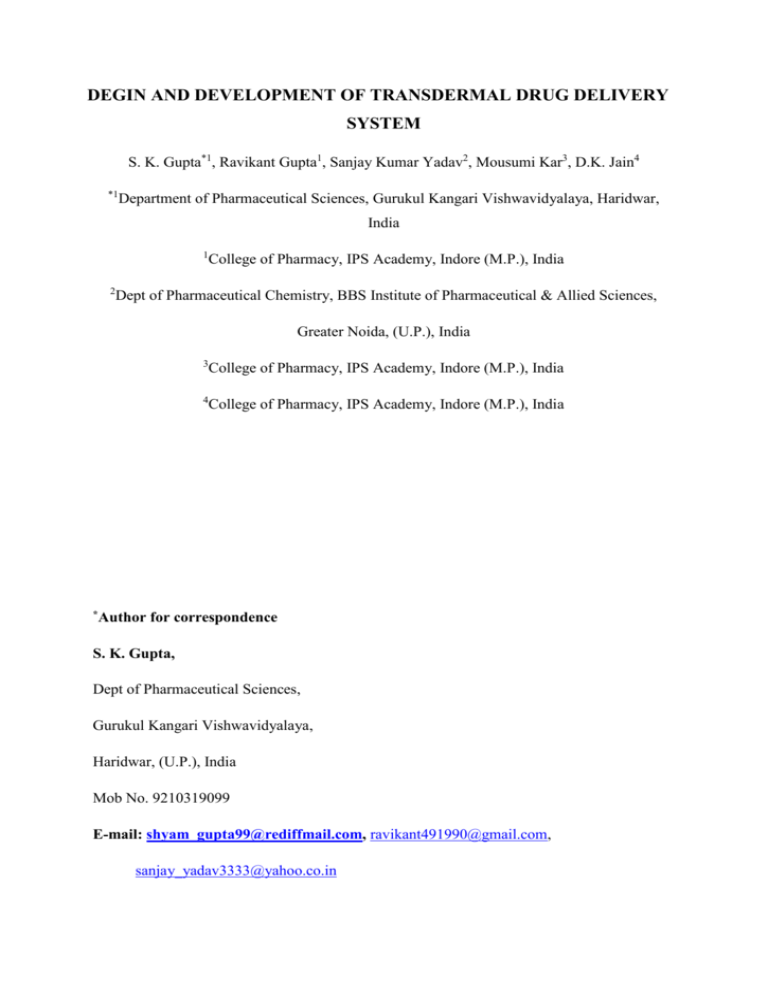
DEGIN AND DEVELOPMENT OF TRANSDERMAL DRUG DELIVERY SYSTEM S. K. Gupta*1, Ravikant Gupta1, Sanjay Kumar Yadav2, Mousumi Kar3, D.K. Jain4 *1 Department of Pharmaceutical Sciences, Gurukul Kangari Vishwavidyalaya, Haridwar, India 1 2 College of Pharmacy, IPS Academy, Indore (M.P.), India Dept of Pharmaceutical Chemistry, BBS Institute of Pharmaceutical & Allied Sciences, Greater Noida, (U.P.), India *Author 3 College of Pharmacy, IPS Academy, Indore (M.P.), India 4 College of Pharmacy, IPS Academy, Indore (M.P.), India for correspondence S. K. Gupta, Dept of Pharmaceutical Sciences, Gurukul Kangari Vishwavidyalaya, Haridwar, (U.P.), India Mob No. 9210319099 E-mail: shyam_gupta99@rediffmail.com, ravikant491990@gmail.com, sanjay_yadav3333@yahoo.co.in ABSTRACT In the course of development of microspheres preparation techniques, the encapsulation of hydrophilic drugs with high entrapment efficiency has been a problem, as the commonly used technique like single emulsification technique and w/o/w double emulsification technique show low entrapment of the hydrophilic drugs. The problem is overcome by using by using w/o/o double emulsification technique, several modifications have been done in this technique one of most widely and effective technique in w/o/o double emulsification is the solvent diffusion technique. In this brief review comparison of w/o/o double emulsification technique with other methods and details about the w/o/o double emulsification technique and the drugs encapsulated using this technique will be discussed. Keywords: Microspheres, w/o/w, w/o/o etc. INTRODUCTION The era of drug technology started with the old conventional systems of delivery of drug to the blood to produce desired therapeutic effect. But these conventional systems have some large limitations. The main limitation of conventional system was that the concentration of drug in blood decreases with time and thus requires administration of another dose to maintain the therapeutic effect i.e. frequent dosing is required.(1) A large number of innovations have taken place in the recent past in the field of drug delivery, which led to preparation of controlled as well as targeted delivery. The main aim of these studies is to provide targeted delivery of drug and maintain the therapeutic concentration of drug at the site of action by offering sustained delivery of drug. Various approaches are studied for the sustained and controlled delivery drug.[2] One of such approach is using microspheres involving microencapsulation technique. Microspheres offer various advantages greater effectiveness, lower toxicity and better stability than conventional dosage forms.[1,2] Microspheres are micro-sized spheres prepared by a judicious blend of polymers with different coat core ratios utilizing various methods- o/w single emulsion solvent evaporation, spray drying, ionotropic gelation, coacervation, air suspension and polymerization. Poorly soluble and lipophilic drugs are successfully retained within the microparticles prepared by this method. However the encapsulation of highly water soluble drugs presents difficult challenge to the researchers. The problem of efficient encapsulation of hydrophilic drugs can be overcome by using double emulsification technique. Double emulsion method of preparation of microspheres involves the formation of multiple emulsions like w/o/w, s/o/w, w/o/o and s/o/o etc. These methods are best suited for incorporation of water soluble drugs, peptides, proteins and vaccines. It involves use of both natural and synthetic polymers.(4) currently w/o/o double emulsification technique has brought the attention of researchers as this method have got high entrapment efficiency for hydrophilic drugs as compared to the w/o/w double emulsification method and single emulsification method.(4,5) COMMONLY USED EMULSIFICATION TECHNIQUE AND THEIR LIMITATIONS SINGLE EMULSIFICATION TECHNIQUE The single emulsion technique using o/w emulsion solvent evaporation method is the oldest and most commonly used technique for microencapsulation. In this method the drug substance is either dispersed or dissolved in the polymer/solvent system. Then it is added to the aqueous phase by continuous agitation. Agitation of the system is continued until the solvent partitions into the aqueous phase and is removed by evaporation. This process results in hardened microsphere which contains the active moiety that is drug. The main limitation of the single emulsification technique in case of hydrophilic drugs is the production of burst release of the drug upon administration due to the accumulation of the drug crystals on the surface of micro particles due to the partitioning of the drug in the aqueous phase of the emulsion (1,2,4). DOUBLE EMULSION TECHNIQUE (W/O/W SOLVENT EVAPORATION AND SOLVENT EXTRACTION TECHNIQUE) w/o/w is one of the most commonly used technique for the encapsulation of the hydrophilic drugs. The process begins with the use of volatile organic solvent to dissolve the polymer. The drug aqueous solution is the dispersed in the polymer solution to form a w/o emulsion. Finally, a w/o/w double emulsion is produced by dispersing the w/o emulsion in water through mechanical mixing. Removal of the organic solvent by evaporation results in the formation of the microspheres. As in case of the single emulsification technique this method have also got some limitation, one of the major limitation is that the hydrophilic drugs easily diffuses into the outer processing medium water, loss of drug during the preparation process is considerable. This is usually distinct drawback in terms of efficient use of drug (1,2,4,5,8). All the above limitations of the above method suggest the need modification of in the processing medium which can bring the encapsulation efficiency nearly 100%. Several researches on the w/o/o emulsification technique recommend it as the most suitable technique for encapsulation of the hydrophilic drugs, as the oil is outer processing medium, so the drug cannot diffuse into the processing medium so the encapsulation efficiency is high. (4,5,10) W/O/O DOUBLE EMULSIFICATION TECHNIQUE In water in oil in oil (w/o/o) double emulsions, the internal aqueous phase and external oil phase are separated by an oil phase. In the w/o/o method, water soluble compounds are first dissolved in the aqueous phase which is emulsified in an oil to form a stable emulsion. The presence of internal water phase helps in the stabilization of emulsion and hardening of the microspheres. This primary emulsion is then dispersed in a solution of polymer in organic solvent to form a w/o/o emulsion. The total drug encapsulation efficiency is high in the microparticles produced by w/o/o emulsification technique since oil is the outer processing medium and protein cannot diffuse into the processing medium. (4) Balaiah A. and co-workers in their study of formulation and development and in-vitro characterization of oral Levetiracetam microspheres, formulated microspheres by both the w/o/o and w/o/w double emulsification technique, reported 30% more encapsulation efficiency in case of w/o/o as compared to w/o/w emulsification technique. So it is clear that w/o/o is more effective in encapsulating the hydrophilic drugs. The only disadvantage of this technique is that larger particle size of the microspheres as compared to the single emulsification technique; several other researches have been done resulting in successful encapsulation of hydrophilic drugs with high entrapment efficiency. (8) In the track of development of the technique researchers used several modifications, different polymers and solvents, extensive study of their work revealed that till date the w/o/o mixed solvent diffusion method is the most promising method for the production of microspheres of hydrophilic drugs. The primary requirement of this method to obtain microspheres is that the selected solvent system for polymer be immiscible with non- aqueous processing medium. Acetonitrile is an exceptional organic solvent which is polar water miscible and oil immiscible, all other polar solvents like methanol, ethanol, acetone etc are oil miscible and will not form emulsions of polymer solution in oil. With oil as processing medium the use of acetonitrile alone doesn’t guarantee the formation of the formation of the primary emulsion, as immediately after mixing the water miscibility of acetonitrile bring about the precipitation of the polymer, hence non-polar solvent namely dichloromethane was included with acetonitrile to decrease the polarity of the polymers solution. Addition of non- solvent towards the end of the process further solidify the microspheres. (3, 6) FORMATION OF MICROSPHERES BY MIXED SOLVENT DIFFUSION METHOD Introduction of water-in-oil emulsion into oil phase leads to the breakdown of the water-in-oil emulsion into tiny droplets and rapid extraction of the dichloromethane. When all the dichloromethane is extracted off, the mixed solvent system becomes one component system, which is water miscible. Simultaneously, the mixture of acetonitrile becomes poor solvent for the polymer and is forced out of the droplet. The migration of the water- acetonitrile mixture occurs through pores in the viscous half-formed microspheres. The phase inversion of the polymer leads to the microporous structure. The fluidity imparted by the water- acetonitrile mixture enables sealing off the pores. (10) Fig. Mixed solvent evaporation technique DRUGS AND BIOPHARMACEUTICALS ENCAPSULATED USING W/O/O EMULSIFICATION TECHNIQUE 1. Metformin hydrochloride: - The microspheres prepared were spherical and porous in nature, 55-85% entrapment and release was extended up to 12h. The drug release was found to be diffusion controlled. Oral administration of microspheres to the albino mice provided decreased plasma glucose for more than 10h. (3) 2. Zidovudine: - The prepared microspheres were spherical and free flowing. The entrapment efficiency was found to be 32-54%. In-vitro drug release profile was found to be diffusion controlled. (6) 3. Levetiracetam: - The microspheres prepared by w/o/o showed better characteristics than the microspheres prepared by w/o/w emulsification method. Initial burst release was observed from all the formulations. The most satisfactory formulation released drug for 24hours. The microspheres were spherical and porous in nature. In- vitro release showed highest correlation with Higuchi model and the drug release was found to be diffusion controlled. (8) 4. Theophylline: - The prepared microspheres were spherical in shape with mean particle size of 757.01µm and loading efficiency of 88.59%. The microspheres were stable revealed crystalline form. (9) 5. Endostatin: - The prepared endostatin microspheres showed encapsulation efficiency of 100% with mean particle size about 25 μm. Endostatin released in vitro from PLGA microspheres were biologically active and significantly inhibited the migration of endothelial cells. In rats, endostatin microspheres produced a sustained release process in which the steady-state concentration was reached from day 5 to day 27 with the steady-state levels of endostatin between 174.8±33.3 and 351.3±126.3 ng/ml. In Lewis lung cancer model, a dose of 10 mg/kg endostatin microspheres was just as effective in suppressing tumor growth as a dose of 2 mg/kg/day free endostatin for 35 days (total dose 70 mg/kg). (10) 6. Niacin:- spherical free flowing microspheres having an entrapment efficiency of 72%. Were obtained. The prepared microspheres showed percentage yield of 85%, particle size range between 405 and 560µm and the drug release was controlled for 10h. the in-vitro drug release profile best fits to highest correlation coefficient in Higuchi model indicating diffusion controlled principle. (11) 7. Tolmetin:- the microspheres were prepared by w/o/o double emulsion solvent diffusion method. The prepared microspheres were spherical, the entrapment efficiency was found to be near theoretical entrapped drug and the release was extended up to 24. The release was influenced by the drug to polymer ratio and particle size and was found to be diffusion and erosion controlled. (12) 8. FITC labeled BSA:- microspheres were prepared by different procedures with an aim to get different particle size by changing the preparative variables. Smooth and spherical microspheres were obtained with high encapsulation efficiency. The particle size reduced as the concentration of the polymer solution reduced. The release of FITC-BSA lasted longer as the particles size increased. (7) 9. Orlistat:- microspheres were found to be regular in shape and highly porous. Microsphere formulation CS4, containing 200mg calcium silicate, showed the best floating ability (88% ± 4% buoyancy) in simulated gastric fluid as compared with other formulations. Release pattern of orlistat in simulated gastric fluid from all floating microspheres followed Higuchi matrix model and Peppas- Korsmeyer model. Prolonged gastric residence time of over 6 hours was achieved in all rabbits for calcium silicate– based floating microspheres of orlistat. The enhanced elimination half-life observed after pharmacokinetic investigations in the present study is due to the floating nature of the designed formulations. (13) 10. Glipizide:- Glipizide microspheres were found to be regular in shape and highly porous. The prepared microspheres exhibited prolonged drug release (~8 h) and remained buoyant for >10 h. The mean particle size increased and the drug release rate decreased at higher polymer concentrations. No significant effect of the stirring rate during preparation on drug release was observed. In vitro studies demonstrated diffusion-controlled drug release from the microspheres. Microsphere formulation CS4, containing 200 mg calcium silicate, showed the best floating ability (88% buoyancy) in simulated gastric fluid. The release pattern of glipizide in simulated gastric fluid from all floating microspheres followed the Higuchi matrix model and the Peppas-Korsmeyer model. (24) 11. BSA:- BSA loaded PLGA microparticles were prepared using a modified w/o/o double emulsion phase separation method . Microspheres with high yield ( >80%) and entrapment efficiency (>90%) were produced using petroleum ether containing 5% (w/v) span 80 as coacervating agent. A biphasic release behavior was observed for microparticles prepared by this method. (14) 12. Stavudine:- The encapsulation efficiency was found satisfactory and it decreased significantly (p<0.05) with increase in drug-polymer concentration. Both the drugpolymer ratio and stirring speed affects the physicochemical properties and release of drug from microspheres. The prepared microspheres satisfactorily released the drug in a sustained and uniform rate following Higuchian kinetics. Sustained release microsphere of stavudine has a potential for oral administration at least once every 12 h. (15) 13. Glucagon like peptide -1(GLP-1):- GLP -1 was micronized or complexed with zinc, which was mixed with PLGA solution in acetonitrile. Mixture was dropped in cottonseed oil containing lecithin. GLP-1 zinc complexation significantly reduced initial burst release from 37.2% to 7.5%. The optimized formulation achieved controlled release in-vivo for 28 days an exhibit sustained long term pharmacological efficacy to decrease blood glucose level in diabetic mice. (16) 14. Vincristine Sulfate:- the vincristine sulfate (VCR) microspheres by W/O/O solvent evaparation method were prepared and the effect of zinc carbonate (ZnCO3) on the morphology and release kinetics of the microspheres were evaluated. ZnCO3 increased the stability of VCR in the PLGA microspheres. During the 36 days of in vitro release, the accumulative release of VCR from the microspheres reached > 70% when added with ZnCO3, and was (54.2 +/- 1.1)% when no ZnCO3 was added. 10% ZnCO3 showed superior effect than 5% ZnCO3 in the stabilization of microspheres. Adding ZnCO3 is essential during the preparation of PLGA microspheres. It can remarkably improve the stability of drugs in the acid microenvironment inside PL-GA microspheres and decrease the VCR degradation during incubation. (17) 15. α-cobrotoxin:- α-cobrotoxin was incorporated into the microspheres composed of poly(lactide-co-glycolide) (PLGA) and poly[1,3-bis(p-carboxy-phenoxy) propane-co–p(carboxyethylformamido) benzoic anhydride (P(CPP:CEFB)) and intranasally delivered to model rats in order to improve its analgesic activity. The microspheres with high entrapment efficiency (> 80%) and average diameter of about 25 μm was prepared by a modified water-in-oil-in-oil (w/o/o) emulsion solvent evaporation method. The presence of P(CPP:CEFB) in the microspheres increased their residence time at the surface of the nasal rat mucosa. The toxicity of the composite microspheres to nasal mucosa was proved to be mild and reversible. A tail flick assay was used to evaluate the antinociceptive activity of the microspheres after nasal administration. Compared with the free α-cobrotoxin and PLGA microspheres, PLGA/P(CPP:CEFB) microspheres showed an apparent increase in the strength and duration of the antinociceptive effect at the same dose of α-cobrotoxin (80 μg/kg body weight). (18) 16. Metoprolol Tartrate:- microspheres of a highly water soluble drug metoprolol tartrate by w/o/o double emulsion solvent diffusion method using ethyl cellulose polymer were prepared. The microspheres obtained were found to be spherical and free flowing. It was found that mean particle size and entrapment efficiency of the microspheres were enhanced with increasing drug-polymer ratio but reduced with increasing stirring speed, processing medium and surfactant concentration. SEM studies confirmed that the formulated microspheres were spherical and uniform in shape, porous and non aggregating in nature. Among all formulations, F5 (Drug:EC::1:1) was found to be the best as it released 91.40% of the drug at the end of 8 h following Higuchi matrix model (R2 =0.987). (19) 17. Nateglinide:- Nateglinide Floating Microspheres were prepared by w/o/o emulsification solvent diffusion technique using rate controlling polymers ethyl cellulose and hydroxy propyl methyl cellulose.The prepared microspheres exhibited prolonged drug release (more than 12 h) and remained buoyant for > 24 h. The mean particle size increased and the drug release rate decreased at higher polymer concentration. In vitro studies demonstrated diffusion- controlled drug release from the microspheres. (20) 18. Simvastatin:- Simvastatin – ethylcellulose microspheres were prepared by water-inoil-in-oil double emulsion solvent diffusion method and evaluated for entrapment efficiency, in vitro drug release behavior, particle size and size distribution. The designed microspheres were spherical, free flowing and size distribution was between 24-48 μm. The entrapment efficiency and percentage yield were 83.67% & 84.31% respectively. The drug release was controlled for 12 h. The in vitro release profiles from optimized formulations were applied on various kinetic models. The best fit with the highest correlation coefficient was observed in Higuchi model, indicated that the release is diffusion controlled mechanism. In vivo pharmacodynamics study of the optimized formulation proved prolonged drug release. (21) 19. Diclofenac Sodium Microspheres were prepared by water in oil in oil emulsion technique using dichloromethane/ethanol solvent system. Span 80 was used as the dispersing agent and n-hexane was added to harden the microspheres. The prepared microspheres were white, free flowing and spherical in shape. The drug-loaded microspheres showed 51.2% of entrapment and release was extended up to 10 h. The in vitro drug release from the microspheres was affected by drug/polymer ratio. The best/fit release kinetics was achieved with Higuchi plot followed by zero order and first order. The release of DFS was influenced by altering the drug to polymer ratio and the drug release was found to be diffusion controlled. (22) 20. Esomeprazole:- The EMT floating microspheres were prepared by double emulsion solvent diffusion method by using Ethyl cellulose and different grades of HPMC like K4M, K15M, using Dichloromethane and alcohol solvent systems. The prepared microspheres were found to be spherical and free flowing and remain buoyant for more than 10 hrs and the particle sizes of microspheres were found to be in the range of 67.24±4.57 μm to 106.35±5.67μm. Incorporation efficiency was found in the range of 54.75±3.51to 83.97±2.54. In-vitro release profile of optimized formulations follows first order non-Fickian (Anomalous) release indicates diffusion and dissolution controlled release. FT-IR and DSC studies revealed the absence of any chemical interaction between drug and polymers used. (23) CONCLUSION w/o/o double emulsification technique has been successfully used to encapsulate hydrophilic drugs. This technique is simple and effective. The results of several researches have proved that this technique provides greater encapsulation efficiency. It provides large scope for further transformation and improvement that are yet to be unfolded. REFERENCES 1. Khar RK, Diwan M. Targeted delivery of drugs. In Jain NK. Advances in controlled and Novel drug delivery. 1st edition. New Delhi. CBS Publisher. 2001: 452-462. 2. Vyas SP, Khar RK. Targeted and controlled drug delivery novel carrier system. CBS publishers and distributors. New Delhi. 2004: 417- 457. 3. Kar M, Choudhury PK. Formulation and evaluation of ethyl cellulose microspheres prepared by multiple emulsion technique. Pharmazie. 2007; 62: 122-125. 4. Giri TK,Choudhary C, Ajazuddin, Alexander A, Badwaik H, Tripathi DK. Prospects of pharmaceuticals and biopharmaceuticals loaded microparticles prepared by double emulsion technique for controlled delivery. Saudi Pharmaceutical Journal. 2013; 21: 125–141. 5. Peter S. Formuation optimization of Ammonio methacylate copolymer based sustained release microspheres. PhD thesis. University of Szeged. Faculty of pharmacy. Department of pharmaceutical technology. 2008. 6. Das MK, Rao KR. Encapsulation of Zidovudine by Double emulsion solvent diffusion technique using ethyl cellulose. Indian J. Pharm. Sci. 2007; 69: 244-250. 7. Ramesh DV, Medlicott N, Razzak M, Tucker IG. Microencapsulation of FITC BSA into poly (ε-Caprlolactone) by water-in-oil-in-oil solvent evaporation technique. Trends Biomater. Artif Organs. 2002; 15: 31-36. 8. Balaiah A, Babu GE, Vijayalakshmi P, Raju KN, Deepika B. Formulation Development and in-vitro Characterization of oral Levetiracetam Microspheres. Int. Res J Pharm App Sci. 2012; 2: 13-21. 9. Jelvehgari M, Dastmalch S, Derfshi N. Theophylline ethyl cellulose microparticles: Screening of the process and formulation variables for preparation of sustained release particles. Iran J Basic Med Sci. 2012; 15: 608-622. 10. Wu J, Ding D, Ren G, Xu X, Yin X, Hu Y. Sustained delivery of endostatin improves the efficacy of therapy in lewis lung cancer model. Journal of Controlled Release 2009; 134: 91-97. 11. Maravajhala V, Dasari N, Sepuri A, Joginapalli S. Design and evaluation of Niacin Microspheres. Indian J Pharm. Sci. 2009; 71: 663-669. 12. Jelvehgari M, Nokhodchi A, Rezapour M, Valizadeh H. Effect of formulation and processing variables on the Characterstics of Tolmetin microspheres prepared by double emulsion solvent diffusion method. Indian J. Pharm. Sci. 2010; 72: 72-78. 13. Jain SK, Agrawal GP, Jain SK. Evaluation of Porous Carrier-based Floating Orlistat Microspheres for Gastric Delivery. AAPS PharmSciTech. 2006; 7 (4): 85-90. 14. Zhang JX, Zhu KJ, Chen D. Preparation of bovine serum albumin loaded poly (D,Llactic-co-glycolic acid) microspheres by a modified phase separation technique. J Microencapsul. 2005; 22 (2): 117–126. 15. Dey S, Mazumder B, Sarkar MK. Comparative study of stavudine microspheres using ethyl cellulose alone and in combination with Eudragit RS100. Malaysian Journal of pharmaceutical sciences. 2010; 8 (2): 45-57. 16. Yin D, Lu Y, Zhang H, Zhang G, Zou H, Sun D, Zhong Y. Preparation of glucagon like peptide-1 loaded PLGA microspheres: characterizations, release studies and bioactivities in vitro/in vivo. Chem. Pharm. Bull. 2008; 56 (2): 156–161. 17. Chen HL, Chen H, Li XM, Yuan P, Zhang QQ. Preparation and characterization of vincristine sulfate-loaded PLGA microspheres. Acta Acad Med Sci. 2007; 29(3): 342346. 18. Li Y, Jiang HL, Zhu KJ. Preparation, characterization and nasal delivery of alpha cobrotoxin-loaded poly (lactide co-glycolide)/polyanhydride microspheres. J Control Release. 2005; 108(1):10-20. 19. Dahiya S, Gupta OM. formulation and in-vitro evaluation of Metoprolol Tartrate microspheres, Bulletin of pharmaceutical research. 2011; 1(1): 31-39. 20. Samal HB, Dey S, Kumar D, Kumar DS, Shreenivas SA, Rahul V. formulation, characterization and in- vitro evaluation of floating microspheres of Nateglide, Internation journal of Pharma and bio science. 2011; 2(1): 147-156. 21. Vidyavathi M, Ramana NV. In- vitro and in-vivo studies on controlled microspheres of Simavastin. IPCBEE. 2011; 24: 89-94. 22. Chella N, Yada KK, Vempati R. Preparation and Evaluation of Ethyl Cellulose Microspheres Containing Diclofenac Sodium by Novel W/O/O Emulsion Method, J. Pharm. Sci. & Res. 2010; 2(12): 884-888. 23. Goudanavar P, Reddy S, Hiremath D and Udupi R. Development and in vitro characterization of esomeprazole floating gastro retentive microspheres. Journal of Applied Pharmaceutical Science. 2013; 3 (03): 071-077. 24. Pandya N, Pandya M, Bhaskar VH. Preparation and in vitro Characterization of Porous Carrier–Based Glipizide Floating Microspheres for Gastric Delivery. J Young Pharm. 2011; 3(2): 97–104.
